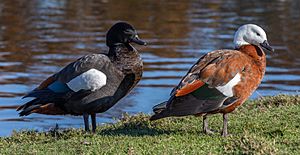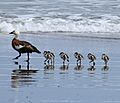Paradise shelduck facts for kids
Quick facts for kids Paradise shelduck |
|
|---|---|
 |
|
| Male, left, female, right, at Lake Victoria, Christchurch | |
| Conservation status | |
| Scientific classification | |
| Genus: |
Tadorna
|
| Species: |
variegata
|
 |
|
The paradise shelduck (Tadorna variegata) is a big, goose-like duck that lives only in New Zealand. It's a special type of duck called a shelduck. These birds are part of a larger bird family known as Anatidae, which includes ducks, geese, and swans. The name Tadorna comes from old Celtic words and means "colorful water bird."
The Māori call this bird pūtangitangi. Today, many people simply call it the "paradise duck." It's a popular game bird in New Zealand. Both male and female paradise shelducks have amazing feathers. The male has a black head and a body with black stripes. The female has a white head and a reddish-brown body. These ducks usually live in pairs. They eat grass and weeds, and sometimes they eat farm crops, especially when they are losing their old feathers.
Contents
What the Paradise Shelduck Looks Like
Paradise shelducks are large, colorful ducks. Their looks are different depending on if they are male or female. Both males and females have reddish-brown feathers under their tails. Their main wing feathers are black, with green feathers on the back part of their wings. The top of their wings are white. They have black legs and webbed feet, which help them swim. Paradise shelducks are usually about 65 cm long. They weigh between 1.5 and 2 kg.
Male Shelducks
Adult male paradise shelducks have a blue-black head and neck. Their back and rump are black, and their tail is also black. Their back and sides have light yellow spots. The male's wings have bright white feathers on top and black flight feathers. They also have shiny green feathers and rusty brown feathers. Males have a dark gray chest and belly with pale yellow spots. Their undertail and underwing are reddish-brown. Their eyes, beak, legs, and feet are black.
Female Shelducks
Female paradise shelducks look different from males. They have a completely white head and neck. Their back is dark gray with many pale yellow spots. The rest of their body is similar to the male's. Their body color can be dark or light reddish-brown. This depends on their age and if they are losing old feathers.
Young Shelducks
When they are very young, paradise shelducks are white and fluffy. They have a brown cap on their head and brown stripes from their head to their tail. Young males look a lot like adult males. Young females are smaller and have a white patch near their beak. Females get their white head after their first molt. Their chest and belly turn dark reddish-brown about one to two months after they learn to fly.
Sounds They Make
The sounds paradise shelducks make are different for males and females. The male makes a two-part honk, like a goose. He does this when he is flying or when he is worried. The male's call is a deep zonk-zonk honk. The female's call is a sharp zeek-zeek.
How They Show Feelings
Paradise shelducks use their bodies to show what they are feeling.
- Threat posture: A male will lower his head very low. His beak will be flat to the ground.
- Inciting: If a female sees something scary in the water, she will stretch out her neck and body. She swims towards the danger, swinging her body back and forth. She makes a loud, high-pitched call. On land, she will lower her head and run towards the threat. The male will often join her or stand tall in a "High and Erect" pose.
- High and Erect: The male stretches his neck and head up and forward. He raises the feathers on his lower neck. He calls quickly and turns between facing the danger and facing the female.
- Broken Wing Display: If a predator threatens a pair with young, the adult ducks will run away from their babies. They crouch down and raise and lower their half-open wings. This is to make the predator follow them instead of the young. Once the predator is far from the babies, one adult will go back to them.
Where Paradise Shelducks Live
New Zealand Home
Paradise shelducks are the most common waterfowl in New Zealand. You can find them on the North Island, South Island, and smaller islands nearby. These include Little Barrier Island, Kapiti Island, Great Barrier Island, and Stewart Island. They are most common on the North Island, especially in Hawkes Bay, Poverty Bay, Taranaki, and Tongariro National Park. Some groups live in Waikato and Wellington. You don't often see them in the Canterbury plains or high in the mountains.
Preferred Places to Live
Paradise shelducks like farmland, grassy areas, and wetlands. They live on both the main islands and smaller islands. They are often found on hilly farms with rich riverbanks, farm ponds, and natural pools on the North Island. On the South Island, they are common in grassy river valleys and lakes in the high country. A few can be found in mountain streams, coastal areas, and salty inlets.
They like to nest near water bodies, which they use as safe places for their young. The depth of the water doesn't matter much. But they do like places where they can see far away from or to the water. Many chosen spots have grass near the water and thick plants for hiding, like reedbeds or forests. This lets the birds eat safely near the water. Lakes surrounded by thick plants might also be chosen for feeding at night.
Life Cycle and Reproduction
Paradise shelducks start laying eggs in early August. Most eggs are laid by the end of August. Sometimes, they lay eggs into October, but rarely into November. The eggs hatch after 30 to 35 days. Only the female sits on the nest for 21 to 22 hours a day. She leaves only at dawn and dusk for about an hour. The male stays near the nest after the eggs have hatched.
The young ducks, called ducklings, learn to fly after about eight weeks. Both parents help care for them during this time. The young birds find their own food but stay close to the nest, usually within 500 meters.
The molting season, when they lose their old feathers, is from December to February. During this time, the birds cannot fly. Long ago, Māori would hunt these birds during molting. They did not hunt during breeding season to help keep the bird numbers healthy. This careful hunting made sure there were always enough birds.
During molting, large groups gather at special places. One- and two-year-old birds arrive first. Then come the birds that didn't have successful nests. Finally, the successful breeding pairs arrive in late January. At molting sites, the birds gather in open water. They like places with high hills around them, which act as good lookout spots. Many sites also have thick plants for hiding.
Adults start leaving molting sites in March or April. They go back to their own breeding areas. Paradise shelducks usually start breeding when they are two or three years old. They form strong pairs that often last their whole lives. They also protect their territories. If one bird in a pair dies, the other will stay in the same territory and find a new mate. They have a long breeding season, from August to December.
Their mating displays are simple. The female might encourage the male to attack other males or females. The male who wins the fight is then chosen as a partner.
Paradise shelducks can nest in many different places. They might nest inside hollow logs, under fallen logs, or in holes in the ground. They also nest in trees up to 20 meters high, in rabbit burrows, under haystacks, or in piles of fence posts. Other spots include grassy clumps, rock cracks, under buildings, among tree roots, or in culverts.
A female usually lays 5 to 15 eggs. If a nest has more than 12 eggs, it's often because two females laid eggs together. About 83% of eggs hatch. And about 89% of the hatched ducklings survive. Paradise shelducks usually live for about 2.3 years. But some live much longer, with the oldest known bird living for 23 years.
Diet, Food, and Dangers
What They Eat
The paradise shelduck is active during the day and eats both plants and animals. Adult birds mostly eat plants. They prefer grasses and clover from pastures. Young ducklings eat mostly water insects for their first five weeks. After that, they start eating plants on land. They can eat many different things. This includes grass, seeds from grasses and weeds, earthworms, insects, and different kinds of crustaceans. One study in New Zealand found that a paradise shelduck's diet included leaves and seeds from land plants, land and water insects, and some water plants.
Dangers and Health
Paradise shelducks originally had no natural enemies. But now, new predators have been brought to New Zealand. These include stoats and polecats. These new predators can threaten smaller groups of shelducks. People also hunt these birds. The number of birds hunted can be from 5% to 48% depending on the area.
The only type of tiny living things that often affect paradise shelducks are helminths. These are worms like flukes, tapeworms, and roundworms. Sometimes, paradise shelducks can get a sickness called avian botulism.
Recently, scientists found a type of bacteria called Chlamydia psittaci in paradise shelducks. This bacteria can cause serious diseases in birds and even in humans. However, scientists are still studying how much this bacteria affects the shelduck populations.
History of the Paradise Shelduck
The Name's Story
The name Tadorna comes from old Celtic words. It means "pied waterfowl," which is similar to the English word "shelduck." Other common names for this bird include Rangitata Goose, Painted Duck, pari/parry/parrie, and pūtakitaki in Māori.
How Their Numbers Changed
In the past, before people settled in New Zealand, there were fewer paradise shelducks. This was because there was more forest cover. But after settlers arrived and cleared land for farms, the number of shelducks started to grow. However, before they could grow steadily, their numbers went up and down a lot. This was because of too much hunting by the settlers.
To help the birds, protective rules were put in place between 1900 and 1920. Hunting was also limited in the South Island from 1923 to 1939. Because of these efforts, the population grew to its highest numbers by 1935. Today, the International Union for Conservation of Nature says the paradise shelduck is a species of "least concern." This means their populations are stable and not in danger.
Gallery
Images for kids
See also
 In Spanish: Tarro maorí para niños
In Spanish: Tarro maorí para niños










